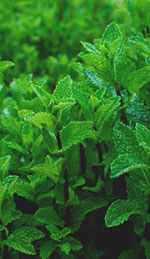 Many people suffer from headaches and migraines, and these conditions can be more than troublesome or aggravating; often, these conditions become debilitating. Tension headaches and sinus headaches can be extremely painful and significantly diminish a person’s quality of life. Migraines, when severe, can completely put a person’s life on hold. Migraine symptoms such as nausea, light sensitivity, and a relentless headache can seriously, negatively impact an individual’s professional and personal life. If you are a headache or migraine sufferer, you may want to consider a natural treatment remedy such as peppermint oil.
Many people suffer from headaches and migraines, and these conditions can be more than troublesome or aggravating; often, these conditions become debilitating. Tension headaches and sinus headaches can be extremely painful and significantly diminish a person’s quality of life. Migraines, when severe, can completely put a person’s life on hold. Migraine symptoms such as nausea, light sensitivity, and a relentless headache can seriously, negatively impact an individual’s professional and personal life. If you are a headache or migraine sufferer, you may want to consider a natural treatment remedy such as peppermint oil.
If you currently use over-the-counter or prescription medications to treat headaches and migraines, you may be exposing yourself to harmful chemicals. The chemicals in these medications can cause future health problems such as hypertension (high blood pressure), stomach bleeding or ulcers, renal insufficiency, liver and heart problems [1]. While the occasional use of painkillers such as NSAIDs (non-steroidal anti-inflammatory drugs) is unlikely to seriously increase one’s health risks, health complications can arise when painkiller use becomes chronic. This is where peppermint essential oil comes in: aromatherapy oils, such as peppermint or lavender, can naturally provide headache and migraine relief without potentially harmful long-term effects.
One of the most popular herbs used in alternative medicine for its gentle effects, peppermint (Mentha x piperita) is a cross between two wild mints, water mint and spearmint. The plant itself has spear-shaped, serrated green leaves and small clusters of purple or white flowers. While peppermint is sometimes found growing in the wild near these two plants, like most hybrids it is usually sterile and must be propagated by humans [2]. The main constituent of peppermint oil is menthol (7-48% of the oil): menthol has a direct cooling effect on the tissues of the body it comes into contact with, making it useful for the direct relief of pain and tissue irritation. The other constituents in peppermint oil include menthone, menthyl acetate, menthofuran, and 1,8-cineol [2].
Peppermint oil can be massaged into the forehead, back of the jaw, and temples, and users will experience a cooling sensation on contact. Within 30 minutes, individuals should feel relief from their headache or migraine. Everyone’s sensitivity levels are different, but peppermint oil can be slightly irritating to the skin. It is recommended to use this oil on a patch of skin first to test for any adverse reactions. If no adverse reactions occur, the oil should be safe to use topically for the effective treatment of headaches and migraines.
There are also several complementary techniques for the prevention and alternative treatment of headache and migraines. Some experts estimate that up to 90% of all non-migraine headaches are tension headaches caused by stress and eye strain [3], often from excessive screen time in front of the computer — something most of us are probably prey to these days at one point or other! The good news is that you can take simple steps to reduce and even prevent most headaches by taking screen breaks at least once per hour during the workday, maintaining a balanced diet, exercising regularly, and — perhaps most importantly — ensuring adequate sleep of at least 7 to 8 hours a night. Limiting caffeine and alcohol intake and practicing relaxation techniques such as yoga, meditation and stretching can also do wonders to decrease the frequency of headaches [3].
Sometimes, especially in the case of migraines, headaches require professional treatment. A couple of promising alternative headache treatments are acupuncture and biofeedback. Acupuncture uses thin needles placed just under the skin to activate the flow of chi, or life force, in the body and remove the blockages in chi believed to cause pain [3]. Biofeedback measures biometrics such as blood flow, muscle tension and skin electricity while a person is experiencing a headache, as well as the intervals between when they are pain free. The goal of biofeedback is to train the person to recognize the sensations that accompany their headaches so they can learn to control them using relaxation techniques [3].
Peppermint essential oil and peppermint tea are thought to help headaches by acting as anti-inflammatory and direct analgesic agents [4]. These actions also make peppermint helpful for treating other types of tissue irritation. Peppermint tea is highly useful for treating occasional indigestion, gas, and stomach upset, and peppermint is listed in the German Commission E’s pharmacopoeia for irritable bowel syndrome (IBS), nasal catarrh, and relieving inflammation of the oral mucosa (mucus membranes) [4]. Peppermint essential oil can be used topically in a carrier oil to treat indigestion via abdominal massage, as well as myalgia (muscle pain) and neuralgia (nerve pain) [4].
Although very beneficial for adults, peppermint oil should not be used on children, especially topically around the face, chest and nasal passages. The menthol content in peppermint oil can cause apnea, respiratory spasm, and even respiratory arrest in children [2]. Some people can be sensitized to topical use of peppermint oil, showing a slight rash from frequently using the straight oil undiluted. If you find that topical use of the oil helps your headache or migraine, but causes a slight skin irritation, then you can still use the oil diluted in a carrier oil like jojoba or olive oil to keep your skin protected.
REFERENCES
1. Sengupta, Krishanu; Krishnaraju V Alluri; Andey Rama Satish; Simanchala Mishra; Trimirtulu Golakoti; Kadainti VS Sarma; Dipak Dey: and Siba P Raychaudhuri. July 30th, 2008. “A double-blind, randomized, placebo-controlled study for the efficacy and safety of 5-Loxin ® for treatment of osteoarthritis of the knee”. Arthritis Research and Therapy 10: R85.
2. “Peppermint” Wikipedia. Last modified July 6th, 2014. http://en.wikipedia.org/wiki/Peppermint.
3. “Health and Balance | Alternative Treatments for Headaches and Migraines”. WebMD. Accessed July 9th, 2014. http://www.webmd.com/balance/nontraditional-headache-treatments.
4. Keifer D., Ulbricht C., Abrams T., Basch E., Giese N., Giles M., DeFranco Kirkwood C., Miranda M., Woods J.”Peppermint (Mentha xpiperita): An evidence-based systematic review by the Natural Standard Research Collaboration.” Journal of Herbal Pharmacotherapy 7 (2) (pp 91-143), 2007.

 The daily demands and pressures of life can be quite distressing, in particular those demands that are work related. Work-related stress is a fact of life with which most individuals deal. Work-related stress not only negatively impacts work performance, but it can also adversely affect personal relationships as well. Stress from work can lead to fatigue, aching muscles, headaches, stomach problems, and emotional difficulties such as anxiety or depression. When you need to relieve work-related stress, you may want to consider using
The daily demands and pressures of life can be quite distressing, in particular those demands that are work related. Work-related stress is a fact of life with which most individuals deal. Work-related stress not only negatively impacts work performance, but it can also adversely affect personal relationships as well. Stress from work can lead to fatigue, aching muscles, headaches, stomach problems, and emotional difficulties such as anxiety or depression. When you need to relieve work-related stress, you may want to consider using